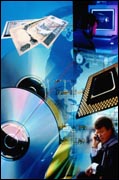When Enron descended into Chapter 11 on December 12, the $63 billion bankruptcy represented the largest-ever filing in modern history, according to the American Bankruptcy Institute. The company’s rapid rise and sudden fall is destined to become the subject of countless case studies and has already spurred politicians to call for new regulations covering everything from accounting services to pension administration. But considered from another viewpoint, Enron is not a groundbreaker. Instead, it is a symbol of a growing trend that is forcing attorneys, accountants and others to consider how to handle a bankruptcy when the debtor company’s possessions are largely composed of intangible assets like intellectual property, patents, licenses and/or contracts. In a recent newspaper opinion piece, Penn law school professor
But Skeel adds that the bankruptcy process, especially a Chapter 11 reorganization, is designed to restructure “bricks and mortar assets that are not going anywhere.” The process, he notes, may get more complicated when intangible assets are involved.
The first problem, of course, lies in identifying the invisible property, like a patent or copyright, which may be buried in a balance sheet. Or in the case of intellectual property, it may literally walk out the door each day with its creator. Additional challenges include assigning a value to items like domain names or customer lists, and determining who in fact owns them. Creditors have been wrestling with this valuation issue on a large scale since at least early 2000 when the Internet bubble burst.
Knowledge-based assets make up a growing proportion of economic valuation, but “people believe that current accounting models really don’t capture their worth,” says Wharton accounting professor David F. Larcker. “For example, despite the fact that [a company] may have intellectual property (IP) that holds significant value, the IP may not in fact have ever been catalogued or identified.”
According to Larcker, as part of a bankruptcy proceeding, a trustee should not only look for patents and other registered intangible assets, but should also search for such undocumented intangible assets as process know-how. “Often a company may not even realize it has valuable information,” he says. “Perhaps the intangible assets are not much use to the business that developed it, but another firm may find them to be very valuable.”
In such a case, notes Larcker, the worth of the intangible asset may be decided in an open auction. “Despite the fact that the IP or other assets are being disposed of at a ’fire sale,’ spirited bidding may lift the price. But it can be difficult to get a handle on just what these assets are worth.”
In some circumstances, say observers, the valuation of an intangible asset may be arrived at through an educated guess, using a discounted cash flow model.
But just how accurate is an “educated guess?” That depends, according to Alfred King, vice-chairman of Milwaukee, Wisc.-based Valuation Research Corp., which furnishes opinions of value for intellectual properties and other intangible assets as well as for business enterprises and fixed assets.
“In some cases valuing an intangible can be fairly straightforward, using discounted cash flow to determine, for instance, what a trade name or brand name will generate,” King notes. “Our company was asked to value the brand names of Nabisco when Philip Morris (which plans to change its name to Altria Group) bought Nabisco. Part of the effort involved determining how much of a premium consumers would pay to buy Ritz crackers instead of a generic or private label brand.”
In Nabisco’s case, the premium could be determined by sampling a representative set of supermarkets and comparing the prices for similar classes of products. But when an e-commerce business, like Amazon.com, or an Internet-portal company, like Yahoo in its early stages, is the subject, it may be tougher to value an intangible asset.
“Since many of the developed (Internet) companies generate revenue but do not yet generate profits, valuation methodology has been modified to include income approaches that consist of price multiples of revenue, customers, registered users, advertisers and other nontraditional indicators,” says King. “One income approach uses a ‘top-down’ analysis whereby the global market potential is first analyzed. A cash flow model is then developed after consideration of market share potential, revenue growth estimates, operating margin expectations, exit earnings multiples and discount rates. Using both models, future cash flow estimates are then discounted back to present value for time value of money and perceived risk.”
He adds, however, that projecting future cash flows and assigning the proper discount rate is a critical process. “Investors are often betting on cash flows they anticipate in the future,” says King. “Therefore, a correct assessment of risk must be performed for the company being valued.”
Finally, the declaration of bankruptcy may itself diminish the value of intellectual property and other intangibles.
“Invariably, some potential buyers will question the value of the intangible assets, considering that the company wasn’t able to succeed,” comments King. “We studied the brand value of a well-known consumer electronics company that declared Chapter 11 and found that its name still carried considerable value. But consider a company like Enron: That name currently has negative connotations and the market value of its intellectual property may now be significantly weakened.”
The type of bankruptcy may also play a part in the valuation process, according to Jim Schnurr, national director of accounting consultation at Deloitte & Touche in Wilton, Ct. “If the assets or the business itself are being sold or otherwise disposed of, the assets would generally be written down to net realizable value,” he says. “If the business is being reorganized and will continue to operate, the company will look at the assets’ value as a continuing business, based on current value and whether there is an impairment of value.”In the case of domain names, for example, Schnurr says a valuation expert would generally look at comparables, including previously executed transactions, for guidance. Some guidance may be forthcoming from the Financial Accounting Standards Board, the Norwalk, Ct.-based body that sets rules for the accounting profession. But as an official there admits, the relief may be limited. “Under FASB Statement No. 141, a recently issued regulation, intangible assets like patents, trade marks, intellectual property and copyrights must generally be valued when they are acquired as part of a business combination,” says Halsey Bullen, a senior project manager with the accounting standards board. “But if a company develops intellectual property internally, it would generally be expensed as R&D.” Bullen adds that FASB is currently involved in a study to determine whether to require footnote disclosure of intangibles that do not appear on a balance sheet, but he estimates the standards board is a year or more away from coming to a decision. Even if the intangible assets of a bankrupt company are identified and valued, creditors may be in for an unpleasant surprise, according to a recent law review article entitled, “Restart.Com: Identifying, Securing And Maximizing The Liquidation Value Of Cyber-Assets In Bankruptcy Proceedings,” published in the American Bankruptcy Institute Law Review. (“Restart” refers to the practice of forcing an Internet company to clean house and voluntarily reorganize its business approach and operations in order to receive a desperately needed infusion of cash). Marjorie Chertok, senior counsel at Morristown, N.J.-based Telcordia Technologies Inc. and a co-author of the ABI paper, notes that an Internet company “may discover that under bankruptcy law it does not have any intellectual capital or other intangible assets to sell because it does not own these assets as a matter of law even if they are used to operate its business.” “The assets may be in name only and thus owned by the founder who invented the programming process, the registrant of the domain name, a venture capitalist who received an assignment of the technology to secure funding, or licensed from a third party who can bar use of the technology in a bankruptcy proceeding,” Chertok comments in her article. “As a result, all that may be sold, if the agreement permits, is the right to use these assets under the terms of the agreement between the debtor and the owner. The liquidator of fashion retailer Boo.com, for example, successfully sold Boo.com’s technology and its web site to competitors.” Although that sale was conducted in the United Kingdom, Chertok indicates that it would be permissible under United States bankruptcy law, “… provided that the assets are in fact owned by the Internet company, as opposed to licensed from third parties or registered or held in the name of non-debtors,” or other situations. Bankruptcy rules were not designed with high-tech businesses in mind, but they are still useful and effective, notes Skeel. “Bankruptcy permits the parties themselves to restructure, without getting the government involved (at least in most cases),” he says. “It keeps companies like Enron from completely exploding.” And the practice of bankruptcy law, as well as valuation of intangible assets, continues to evolve.



